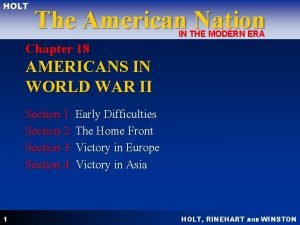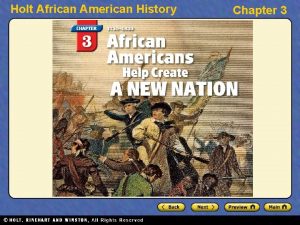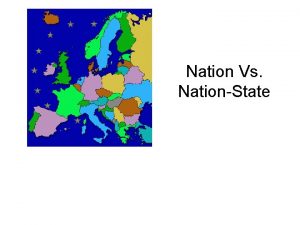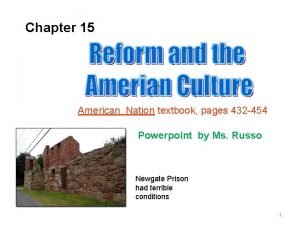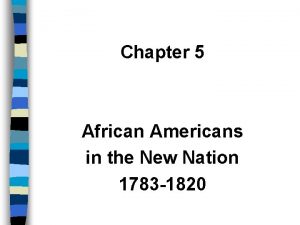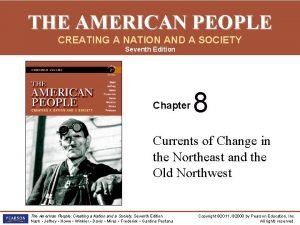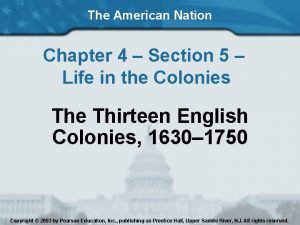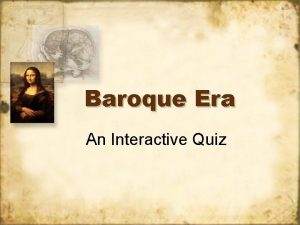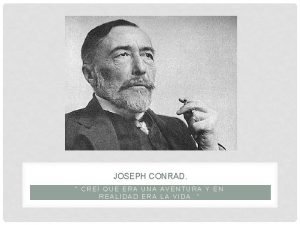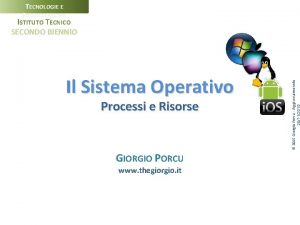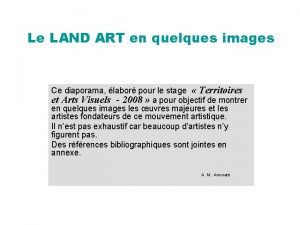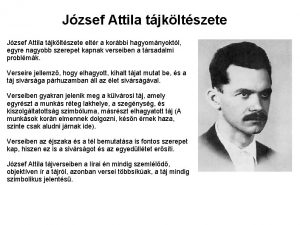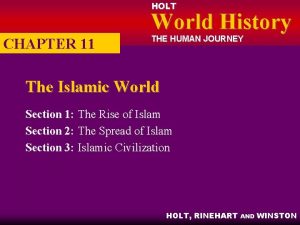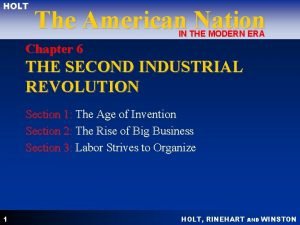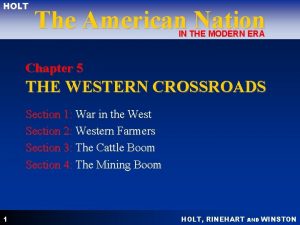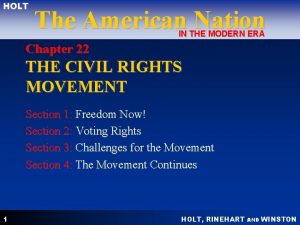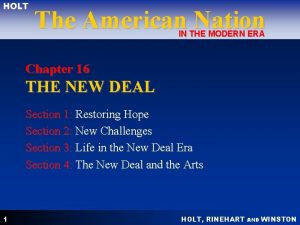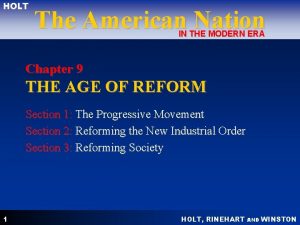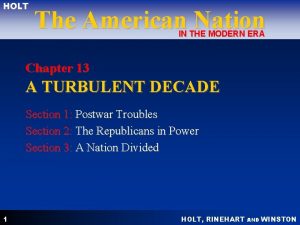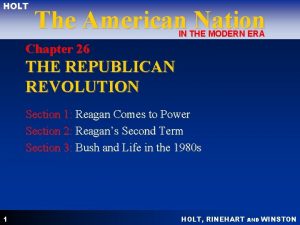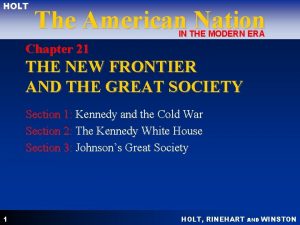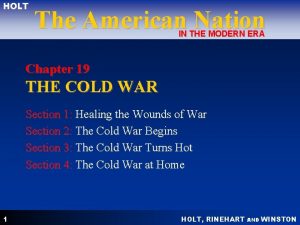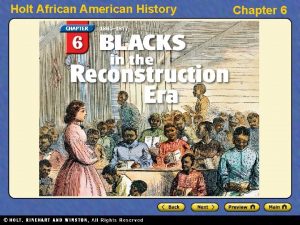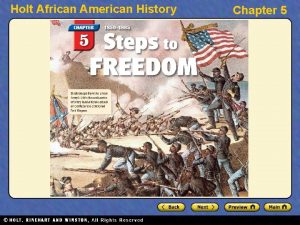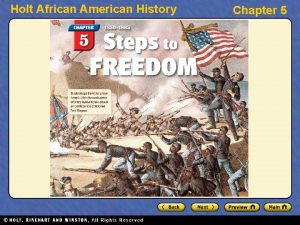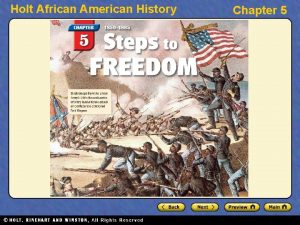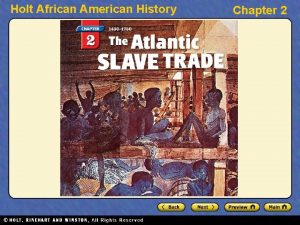HOLT The American Nation IN THE MODERN ERA



















- Slides: 19

HOLT The American Nation IN THE MODERN ERA Chapter 24 WAR IN VIETNAM Section 1: Background to Conflict Section 2: The War Escalates Section 3: A Turning Point Section 4: The War Ends 1 HOLT, RINEHART AND WINSTON

HOLT The American Nation IN THE MODERN ERA Section 1: Background to Conflict Objectives: l Why did China and France want to control Vietnam? l Why did the United States refuse to support Vietnamese independence in the 1940 s and 1950 s? l Why did President Kennedy increase U. S. involvement in Vietnam? 2 HOLT, RINEHART AND WINSTON

HOLT The American Nation IN THE MODERN ERA Section 1: Background to Conflict Reasons for wanting control of Vietnam l China wanted Vietnam’s agricultural resources. l France was imperialistic and wanted colonial possessions. 3 HOLT, RINEHART AND WINSTON

HOLT The American Nation IN THE MODERN ERA Section 1: Background to Conflict Lack of American support for Vietnamese independence l valued France as an ally against communism l disliked Ho Chi Minh’s affiliation with Communist Party l feared the domino effect in Southeast Asia 4 HOLT, RINEHART AND WINSTON

HOLT The American Nation IN THE MODERN ERA Section 1: Background to Conflict Reasons for increasing American involvement l Kennedy believed in the domino theory. l Kennedy wanted to improve U. S. image in the world. 5 HOLT, RINEHART AND WINSTON

HOLT The American Nation IN THE MODERN ERA Section 2: The War Escalates Objectives: l What constitutional issue did the Tonkin Gulf Resolution raise? l What strategies did U. S. forces use in the Vietnam War? l What role did the media play in the Vietnam War? l Why did some Americans oppose the war, and how did the government respond? 6 HOLT, RINEHART AND WINSTON

HOLT The American Nation IN THE MODERN ERA Section 2: The War Escalates The Tonkin Gulf Resolution and the Constitution The Tonkin Gulf Resolution gave the President the power to respond to aggression without Congressional approval, which meant Congress gave up its constitutional power to declare war. 7 HOLT, RINEHART AND WINSTON

HOLT The American Nation IN THE MODERN ERA Section 2: The War Escalates U. S. strategies l escalation l bombing of targets in the North, then areas of Laos and much of South Vietnam l use of defoliants and napalm l search-and-destroy missions l pacification 8 HOLT, RINEHART AND WINSTON

HOLT The American Nation IN THE MODERN ERA Section 2: The War Escalates Role of the media l fewer press restrictions than ever before l showed graphic images of the horror of war l gave information concerning corruption in Diem regime and ineptitude of South Vietnamese troops l caused Americans to doubt whether the war was right l caused Americans to doubt if the war could be won 9 HOLT, RINEHART AND WINSTON

HOLT The American Nation IN THE MODERN ERA Section 2: The War Escalates American opposition to the war l opposed all wars l thought Vietnam War took money from social programs l believed Vietnam was not crucial to U. S. security l feared that nuclear weapons would be used Government response The government insisted that the U. S. was defending an ally against aggression. 10 HOLT, RINEHART AND WINSTON

HOLT The American Nation IN THE MODERN ERA Section 3: A Turning Point Objectives: l Why did the Tet Offensive weaken many Americans’ confidence in their government? l What were the key events of the 1968 presidential campaign? l How did President Nixon attempt to end the war? l How did Americans react to President Nixon’s plan to end the war? 11 HOLT, RINEHART AND WINSTON

HOLT The American Nation IN THE MODERN ERA Section 3: A Turning Point The Tet Offensive l revealed that no part of South Vietnam was secure l exposed how few South Vietnamese supported their own government l revealed how determined the North Vietnamese were 12 HOLT, RINEHART AND WINSTON

HOLT The American Nation IN THE MODERN ERA Section 3: A Turning Point Key events in 1968 campaign l March: Mc. Carthy nearly ties Johnson in the New Hampshire primary. l March 31: Johnson withdraws. l June: Robert Kennedy wins California primary and is assassinated. l August: Police attack antiwar protesters at Democratic convention in Chicago. l November: Nixon wins. 13 HOLT, RINEHART AND WINSTON

HOLT The American Nation IN THE MODERN ERA Section 3: A Turning Point Nixon’s attempts to end the war l begins Vietnamization and gradual withdrawal of American troops l orders widespread bombing in Cambodia 14 HOLT, RINEHART AND WINSTON

HOLT The American Nation IN THE MODERN ERA Section 3: A Turning Point American reaction l Bombing and invasion of Cambodia caused outrage. l Campus unrest escalated, including the Kent State shootings. l Congress repealed the Gulf of Tonkin Resolution. 15 HOLT, RINEHART AND WINSTON

HOLT The American Nation IN THE MODERN ERA Section 4: The War Ends Objectives: l Why did the United States agree to a cease-fire in January 1973? l What long-term effects did the war have on Vietnam and the Vietnamese people? l What long-term effects did the war have on Americans? 16 HOLT, RINEHART AND WINSTON

HOLT The American Nation IN THE MODERN ERA Section 4: The War Ends The cease-fire of 1973 l In October of 1972, North Vietnam and the U. S. agreed on a peace plan. l South Vietnam’s president, afraid of losing power, rejected the agreement. l North Vietnam demanded the agreement be reinstated, but Nixon ordered round-the-clock bombing of Hanoi and Haiphong instead. l Intensive bombing did not sway the North Vietnamese. l A new agreement, not very different from the first, was reached in January, 1973. 17 HOLT, RINEHART AND WINSTON

HOLT The American Nation IN THE MODERN ERA Section 4: The War Ends Long-term effects on Vietnam and its people l Estimates of dead, orphaned, and disabled ran into millions. l Economy devastated. l North Vietnam united with South Vietnam in 1975. 18 HOLT, RINEHART AND WINSTON

HOLT The American Nation IN THE MODERN ERA Section 4: The War Ends Long-term effects on Americans l More than 60, 000 killed and missing, more than 300, 000 wounded. l Veterans badly treated for years. l Americans lost faith in their government. l Congress passed the War Powers Act. l National debt grew and inflation was fueled. 19 HOLT, RINEHART AND WINSTON
 Holt american nation
Holt american nation Holt african american history
Holt african american history Country vs nation
Country vs nation Nation state vs nation
Nation state vs nation State vs nation
State vs nation American nation textbook
American nation textbook Chapter 5 african american in the new nation
Chapter 5 african american in the new nation The american people creating a nation and a society
The american people creating a nation and a society American nation chapter 4
American nation chapter 4 American nation chapter 4
American nation chapter 4 Baroque music quiz
Baroque music quiz Elizabethan vs victorian
Elizabethan vs victorian Creí que era una aventura y en realidad era la vida
Creí que era una aventura y en realidad era la vida Poema sobre as estrelas
Poema sobre as estrelas Grafo di holt riducibile
Grafo di holt riducibile Token economy psychology
Token economy psychology Hobbs and holt token economy
Hobbs and holt token economy Betty beaumont land art
Betty beaumont land art Holt vidék elemzés
Holt vidék elemzés World history the human journey answer key
World history the human journey answer key
